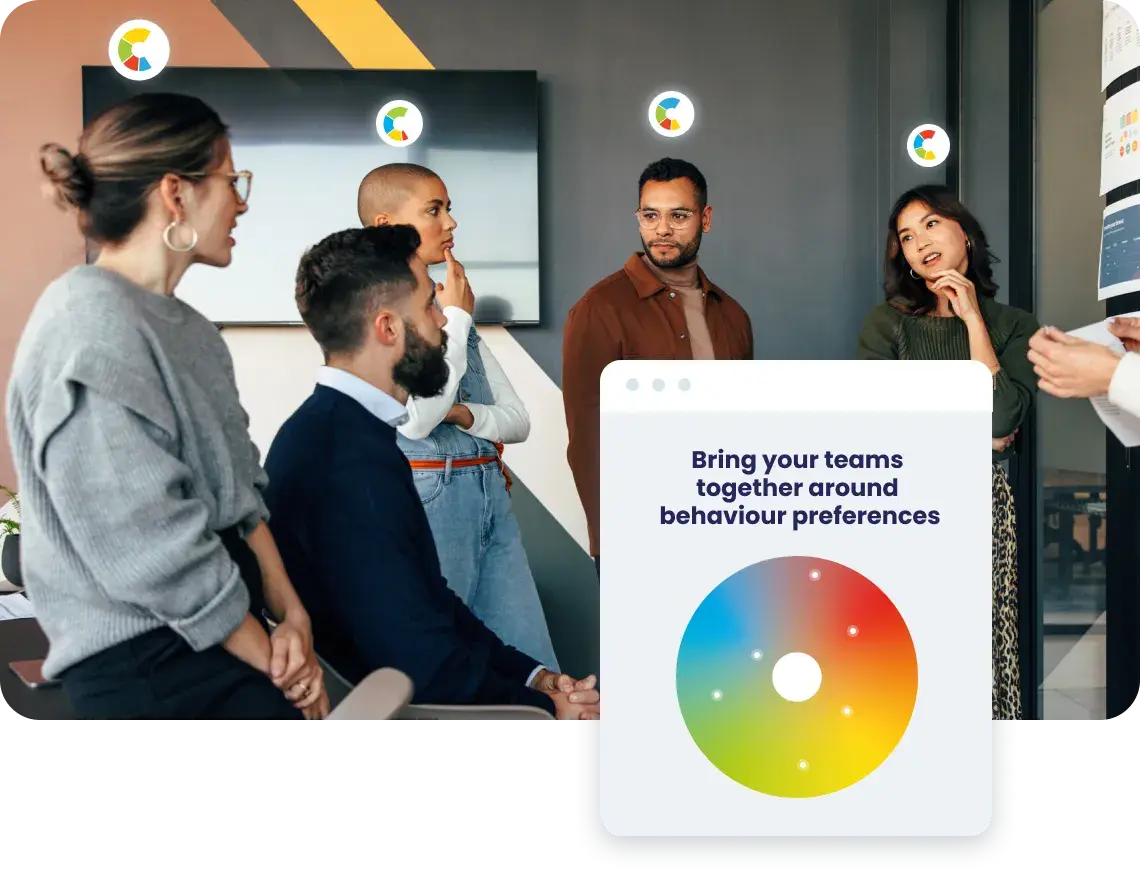
What is psychometric profiling? A guide to unlocking employee success
In this short guide we will walk through the ins and outs of psychometric profiling, giving you the knowledge to make an informed decision about the right tool for your business.
Psychometric profiling is a process of understanding an individual's personality, behavioural style, and reasoning skills using a data-directed, objective, and structured approach.
Think of it like a decoder, helping you to understand what makes your employees tick. Depending on the tool you choose, you could gain insights into their personality traits, cognitive abilities, and behavioural patterns.
Psychometric profiling performs a valuable service for organisations of all sizes. For example, helping to make better hiring decisions, improve employee performance and team dynamics, and create a more positive work environment.
How is psychometric profiling related to psychometrics?
Psychometric profiling is part of a larger field called psychometrics:
Psychometrics is a field of study within psychology concerned with the theory and technique of measurement. Psychometrics generally refers to specialized fields within psychology and education devoted to testing, measurement, assessment, and related activities. Psychometrics is concerned with the objective measurement of latent constructs that cannot be directly observed. Examples of latent constructs include intelligence, introversion, mental disorders, and educational achievement.
From Wikipedia
Psychometric profiling, on the other hand, is a specific application of psychometrics that focuses on using tests and assessments to create a comprehensive profile of an individual's psychological attributes, strengths, and abilities. While psychometrics covers a broad range of assessment methods, psychometric profiling is more targeted and tailored to specific objectives, such as personal development, team building, leadership assessment, or talent management. It uses data-driven insights to understand individuals on a deeper level and make informed decisions in various contexts, such as recruitment, training, and organisational development.
What is the difference between psychometric profiling and psychometric testing?

Psychometric testing refers to the process of administering and scoring tests which gather data about an individual's psychological attributes. On the other hand, psychometric profiling takes it a step further by interpreting and analysing that data to create a comprehensive profile of your employees' psychological makeup. Perhaps think of it like the difference between a simple snapshot and a detailed portrait.
However, the two terms are often used interchangeably and perhaps often understood to mean the same thing – testing and then understanding a person’s psychological attributes and makeup.
A potted history of psychometric profiling

The history of psychometric profiling can be traced back to the early 20th century, when psychologists began to develop standardised tests to measure intelligence and other psychological constructs. These early tests were often used in educational settings to assess student aptitude and achievement.
In the mid-20th century, psychometric profiling began to be used in business settings. Companies began to use psychometric tests to select employees, assess performance, and develop training programs.
Today, it is a widely used tool in businesses of all sizes to improve their hiring, performance management, and training programs.
For a more detailed timeline on the history of psychometric testing and profiling see our blog Accurate Personality Assessments: Discover Yourself.
Now that you understand the distinction between psychometric profiling, psychometric testing, and psychometrics, let's explore why you should embrace psychometric profiling in your organisation.
Why use psychometric profiling?

Imagine having a crystal ball that reveals your employees' strengths, weaknesses, and untapped potential – perhaps psychometric profiling is the closest we can get. Here is a list of some of the most compelling reasons for why you should use it:
- Uncover hidden potential: Unearth hidden talents and abilities within your workforce and understand what makes your employees unique, enabling you to harness their strengths and align them with the right opportunities.
- Objective insights: Standardised data removes a large part of the guesswork in understanding your employees, providing more solid information to base decisions upon, reducing bias and subjectivity.
- Build effective teams: Put together dream teams. Analyse the profiles of your employees collectively to more easily identify complementary strengths, address potential conflicts, and foster better collaboration and synergy among team members.
- Enhance personal development: Help to empower individuals to embark on a journey of self-discovery and growth. With insights into their personality traits, cognitive abilities, and behavioural patterns, employees can identify areas for improvement and develop targeted development plans that acknowledges their personal strengths and areas for development.
- Streamline recruitment: Make it easier to find the right fit for your organisation. Draw on valuable data on candidates' personality traits, cognitive abilities, and job fit. Make more informed hiring decisions and select candidates who align with your organisation's values and requirements.
- Boost leadership effectiveness: More successfully developed leaders who could play a vital role in driving organisational success. Identify leadership potential, assess leadership styles, and highlight areas for development. Use this knowledge to design targeted leadership development programs and cultivate effective leaders within your organisation.
- Foster a positive work culture: Better understand your employees' psychological attributes and needs, to support you in creating a supportive work culture. By tailoring your management approaches, communication strategies, and recognition programs to align with their preferences, you are better equipped to foster a positive and engaging work environment.
- Improve performance appraisals: Gain a valuable and personalised perspective to performance appraisals which, when combined with feedback, provides a more holistic view of employee performance, to then establish better tailored development plans.
Next, we will explore the various types of psychometric profiling and their applications.
Types of psychometric profiling

Psychometric profiling comes in various forms, each targeting different aspects of an individual’s psychological makeup. Here are some of the most common forms:
- Personality profiling: Designed to delve into an individual's personality traits, providing insights into their behaviour, communication style, and preferences. These assessments can be used to understand how individuals interact with others, how they approach tasks, and how they make decisions.
- Behavioural profiling: Behavioural profiling measures an individual's behavioural style, such as their preferred way of interacting with others, their work style, and their decision-making style. This type of profiling can be used to understand how individuals interact with others, how they approach tasks, and how they make decisions. They are invaluable for team building, personal development, and improving interpersonal dynamics.
- Cognitive ability profiling/Intelligence profiling: This kind of profiling measures an individual's mental abilities, including problem-solving, logical reasoning, and critical thinking. Particularly helpful in evaluating an employee's overall intellectual potential and their capacity to handle complex tasks.
- Emotional intelligence profiling: The focus of emotional intelligence profiling is on an individual's ability to recognise, understand, and manage emotions, both in themselves and others. These assessments provide insights into an employee's interpersonal skills, empathy, and self-awareness.
- Skill-based profiling/Aptitude profiling: Skill assessments measure an individual's proficiency in specific areas relevant to their role, such as technical skills, problem-solving abilities, or communication skills. This type of profiling can be used to assess an individual's potential for success in a particular job or role. These assessments are beneficial in training and development planning, talent management, and succession planning.
- Leadership profiling: Leadership assessments evaluate an individual's leadership style, strengths, and areas for growth, helping to identify future leaders, enhance leadership effectiveness, and inform leadership development initiatives.
This is not an exhaustive list, the right choice for your organisation depends on your specific goals and requirements.
Are there any disadvantages to psychometric profiling?

While psychometric profiling offers numerous benefits, there are potential limitations, which are important to be aware of. However, they do not outweigh the advantages when given proper consideration:
- Data interpretation challenges: Psychometric assessments provide valuable data, but interpreting and making decisions based solely on test results can be complex. It is important to combine assessment data with other sources of information, such as performance evaluations and behavioural observations, for a well-rounded view.
- Individual differences and context: The assessments focus on individual attributes, but it is essential to recognise that people are influenced by their environment and circumstances. Factors such as job context, motivation, and external stressors can impact employee performance and behaviour.
- Potential bias: The assessments are designed to be objective, but there is still a possibility of bias in the interpretation or application of the results. It is crucial to ensure that the assessment process is fair, transparent, and free from discrimination.
- Snapshot in time: Psychometric profiling provides insights based on the data collected at a specific point in time. We must remember that individuals can evolve and change over time. Therefore, the profiles should be viewed as a starting point for development and not as a fixed label.
Despite these potential limitations, when used responsibly and in conjunction with other assessment methods and qualitative feedback, psychometric profiling can be a hugely valuable tool for understanding employees and supporting their growth and development.
How can psychometric profiling be used in business?

- Personal development: Help individuals gain self-awareness about their personality, behavioural style, and cognitive abilities – identifying strengths and areas for improvement that can contribute to targeted development plans and career choices.
- Team dynamics: By analysing team members' profiles and how they interface, psychometric profiling can facilitate more effective team collaboration due to understanding how each other are motivated and achieve success. The natural outcome is improved team synergy and performance. The data can also be used to form higher performing teams from the very start.
- Communication soft skills: Psychometric profiling can have an immediate impact upon employee interpersonal communication and team dynamics by providing practical insights into individuals' preferred communication styles.
- Recruitment success: When used correctly, psychometric profiling is a great asset in the latter stages of the selection process to assess how candidates may fit within specific teams and company culture. They are predictive profiles, providing valuable information for interview questions.
- Talent management: Draw on profiling data to identify the potential of all employees in your organisation, and especially high-potential employees. Use the insights to better match individuals to suitable roles, talent pipelines and succession plans.
- Learning and development: Discover learning preferences through psychometric profiling to aid you in the design of customised training programs aligned with individuals' strengths and development areas.
- Leadership development: More effectively identify leadership potential and leadership styles, and better tailor leadership development programs for aspiring leaders.
- Performance appraisals: Gain a more comprehensive understanding of employee performance, strengths, and areas for improvement by combining psychometric profiling data with performance evaluations.
- High-performing, healthy working culture: Psychometric profiling specifically contributes to building a positive work culture by promoting self-awareness and awareness of others’ preferences. These insights can help foster more effective team communication, understanding and appreciation of ‘difference’ to avoid conflict and aid better collaboration.
- Organisational alignment: Draw on profiling data to align individual strengths with organisational goals.
These are just a few examples of how psychometric profiling can be applied in a business context. The versatility and insights that can be gained from this kind of profiling make it a valuable tool for most HR functions and organisational development initiatives.
Tips for choosing the right psychometric profiling tool for your business

With a wide range of options available, choosing the right psychometric profiling tool can be a challenge. Here are some tips to help you make an informed decision:
- Define your objectives: Clearly outline your goals and objectives for using psychometric profiling in your organisation. Identify the specific outcomes you want to achieve, such as improving team dynamics, enhancing leadership effectiveness, or supporting recruitment decisions.
- Consider your target population: Consider the characteristics of the individuals who will be assessed – for example, their roles, levels of experience, and diversity. Check that the profiling tool you are considering is suitable and applicable to your target audience.
- Evaluate validity and reliability: How does the tool provide consistent and accurate results? Look for a psychometric profiling tool that has undergone validation and reliability testing.
- Review reporting and interpretation: Examine the quality and clarity of the reports generated by the tool. Find out if the results are presented in a user-friendly and actionable format, with clear interpretations and practical recommendations. Ask yourself – ‘How easily can this information be understood and actioned by our employees?’ This is going to facilitate more effective integration of assessment results into your employees’ every day working life and development plans.
- Consider the support and expertise of the provider: Assess the expertise of the provider. Do they have a track record of delivering successful assessments? Who for? What is their support process to ensure the success of the tool in your organisation?
- Test the tool in your context: Can you trial the tool on a small group in your organisation to test the resonance of the results and impact in your environment?
- Consider integration and compatibility: Evaluate whether the psychometric profiling tool can integrate with your existing HR systems and processes.
Choosing the right psychometric profiling tool is a crucial decision that can greatly impact the effectiveness of your assessments and the subsequent actions you take based on the results. Take the time to research and evaluate your options to ensure that you select a tool that aligns with your organisation's goals, provides reliable and valid results, and is supported by a reputable provider.
Best practices when using psychometric profiling

To make the most of psychometric profiling in your organisation, here are some best practices to keep in mind:
- Communicate with transparency: Ensure that employees understand the purpose and benefits of your chosen psychometric profiling tool. Clearly communicate that the assessments are meant for personal and professional development, not to discriminate against them, and emphasise the confidential nature of the process.
- Provide comprehensive feedback: Offer employees detailed feedback on their assessment results. This feedback should focus at the very least on strengths, areas for development, and actionable recommendations. Encourage open discussions to help individuals gain a deeper understanding of their profiles and how to leverage them for growth.
- Integrate results with development plans: Use the insights gained to identify targeted areas for growth and, if you have them, incorporate results into personalised development initiatives and training programs. By connecting the outcomes of the psychometric assessments with individual development plans you will underscore the value of the process.
- Combine multiple assessment methods: Psychometric profiling should not be the sole basis for decision-making. Supplement the results with other assessment methods, such as performance evaluations and 360-degree feedback, to gain a holistic view of an employee's capabilities and potential.
- Provide training for interpretation: Ensure that managers and professionals involved in interpreting the psychometric profiling results receive proper training. This will equip them with the knowledge and skills to accurately interpret the data and provide meaningful guidance to employees.
- Promote self-reflection and development: Encourage employees to reflect on their assessment results and take ownership of their development. Empower them to set goals, explore opportunities for growth, and seek out resources or support that align with their identified strengths and development areas.
- Regularly review and update assessments: Regularly review your chosen assessments to ensure their continued validity and relevance in the ever-changing organisational landscape.
In conclusion
Psychometric profiling is a powerful tool that can help you to improve your learning and development programmes, team dynamics, employee personal development and performance, hiring decisions and build a more positive work environment.
In this blog, we have aimed to provide an overview of psychometric profiling and its benefits, including a discussion of some of the factors to consider when choosing a psychometric profiling tool. We hope that this information has helped you understand its value and better enabled you to make an informed decision about the right tool for your business.
Find out how C-me delivers psychometric profiling in the form of behavioural preference profiling in our blog Why behavioural assessments are more effective in business than personality tests to help you build high performing teams, address employee engagement, improve recruitment and onboarding success, select and develop leaders and managers, improve team communications and dynamics, and even deliver insights at an organisational level.
Frequently Asked Questions
- Personality Profiling: Examines personality traits, communication styles, and behavioral preferences.
- Behavioral Profiling: Assesses work styles, decision-making, and interpersonal interactions for team building.
- Cognitive Ability/Intelligence Profiling: Measures problem-solving, logical reasoning, and critical thinking skills.
- Emotional Intelligence Profiling: Evaluates self-awareness, empathy, and emotional management.
- Skill-Based/Aptitude Profiling: Assesses role-specific skills like technical or communication abilities.
- Leadership Profiling: Identifies leadership styles and potential for leadership development. The right type depends on organisational goals.
- Data Interpretation Challenges: Results can be complex, so they should be combined with performance evaluations and behavioural observations for a holistic view.
- Individual Differences and Context: External factors like job context or stress can influence results, requiring careful consideration.
- Potential Bias: Objective design minimises bias, but fair and transparent application is essential.
- Snapshot in Time: Profiles reflect a moment in time, so regular reviews ensure ongoing relevance. When used responsibly alongside other methods, these limitations are outweighed by the benefits.
- Personal Development: Enhances self-awareness and targeted growth plans.
- Team Dynamics: Improves collaboration by understanding individual motivations and strengths.
- Communication Skills: Provides insights into preferred communication styles to enhance interpersonal dynamics.
- Recruitment: Predicts job fit and team compatibility, reducing turnover.
- Talent Management: Identifies high-potential employees for succession planning.
- Learning and Development: Designs customized training based on learning preferences.
- Leadership Development: Tailors programs to enhance leadership effectiveness.
- Performance Appraisals: Offers a comprehensive view of employee performance.
- Work Culture: Promotes a positive environment through tailored management strategies.
Sign-up for a free trial here:
C-me: One platform with multiple applications





